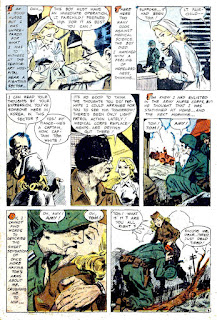Translate
Monday, November 29, 2021
Number 2579: The short-lived Stuntman
Stuntman may have suffered a bit by changing tastes among comic book readers. Stuntman wore his circus costume, then added a helmet and went from circus stuntman and daredevil to two-fisted costumed hero. The artwork is dynamic, but costumed heroes were passé, and if comic books truly glutted the market, then many potential readers might not have seen it. It is also possible the distributors didn’t give shelf space to a comic book with no sales record.
Harvey not only published the original Stuntman #1, but also reprinted “Killer in the Big Top” twice, in Black Cat #9 (1948), and Thrills of Tomorrow #19 (1955). What I think is precedent is the first page banner that asks the reader to “Save this first issue of Stuntman comics...it will be a valuable souvenir someday.”
From Stuntman #1 (1946):
Thursday, November 25, 2021
Number 2578: ...and the 2021 Thanksgiving Turkey Award goes to...
With Hanks it is almost too easy, but stacked up against other comic book creators from the early years of the comic books, he was then an original, and still lives in our hearts as the man whose creations, artwork, dialogue, etc., are unique. I say “unique” although several comic book creators from the late '30s and early '40s had their own bizarre visions, but no one seemed to be as bizarre as Hanks, and that isn’t just my opinion, but the opinion of everyone who writes about Hanks.
I rarely give four turkeys as an award, but Hanks undoubtedly gets about as close as one can get to my vision of a perfect turkey, therefore today’s choice earns the rare four turkeys.The episodes of “Space Smith” and “Stardust” by Hanks were published in the same issue of Fantastic Comics #3 (1939].
Wednesday, November 24, 2021
Number 2577: Jo-Jo’s hot medicine
Fox had a comic book called Jo-Jo Comics, which was designed for young children. It was canceled and the former title became the Congo King's name. It was done because second class mailing permits were expensive. Keeping the title, albeit with totally different contents, made it possible to continue the title and not have to pay for a new permit. A tactic I have mentioned a few times in this blog.
The Public Domain web site gave the names of women, who appeared as Jo-Jo’s girlfriend (“love interests," as claimed by PDSH). In this story the voluptuous two-piece garb wearer is Gwenna. Other names of the sexy female leads are Geesha, Yolda, Safra, and Mioa. Jo-Jo’s girlfriend list was packed.
From Jo-Jo #7A,* 1946:
*There were two issues numbered “7”, so for purposes of keeping track, one is #7A, the other #7B. This story is from #7A. The Grand Comics Database says, “There are two #7s. Numbering is corrected with #14, skipping #13.” Skip #13? Was someone at Fox Features superstitious?
Come back tomorrow for the annual Thanksgiving Turkey Awards.
Monday, November 22, 2021
Number 2576: The comic artist who became the fine artist
A few months ago I showed a story by artist Everett Raymond Kintsler. It was a romance comic, like today’s posting. Far back in my past (50 years ago...yikes) I saw a couple of Kintsler comic book stories and thought his work didn't belong in comic books. My prejudices at the time were that comic book stories should look more like comic books than illustration. My complaint was that Kinstler’s art style looked more like those illustrations in slick magazines. Comic books just seemed like a whole other place, and purpose, than the illustrative work Kinstler did. I have changed my mind over those years, and now see his work as being solid story telling, but drawn with lines that were in vogue during the time of James Montgomery Flagg. Kinstler said more than once that Flagg was his inspiration, so an acolyte of Flagg ended up drawing comic books. Kinstler never disavowed his years in the comics, and I am sure they helped him learn how to draw just about everything needed in comics, which was also useful in his later art career.
Kinstler left comics and went into fine art. I admire that. He went on to do some great work. He died in 2019, age 92.
From Realistic Romance #8 (1952):
Monday, November 15, 2021
Number 2575: “...and a parrot called Snoopy”
How many characters of the early war years were in the armed services, and when the enemy struck the home front, dropped their uniforms for a (usually) colorful, masked character? Twilight, in that way, is not very original, but his parrot, named “Snoopy,” is colorful, at least.
Artist John Cassone did his usual superb job on the drawing. From Clue Comics #3 (1943).





















































